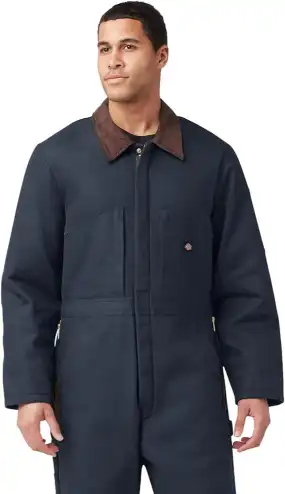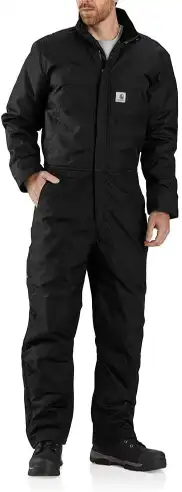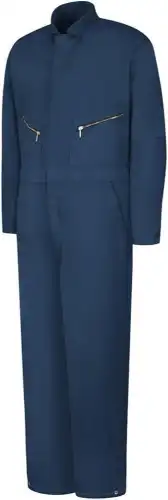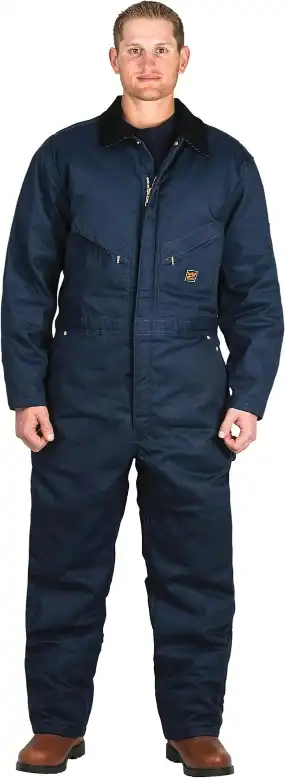Insulated coveralls, also known as thermal overalls, are a type of protective clothing designed to keep the body warm in cold conditions. They are typically made from durable materials and lined with insulation to trap body heat. Insulated coveralls are a staple in many industries, including construction, agriculture, and outdoor recreation.
Staying warm and comfortable in harsh conditions is not just about comfort. It’s a matter of safety. Exposure to cold temperatures can lead to hypothermia and frostbite, both of which can be life-threatening. Insulated coveralls provide a layer of protection against these risks, making them an essential piece of gear for anyone working or playing in cold environments.
Furthermore, insulated coveralls can also improve productivity. When you’re warm and comfortable, you’re able to focus better on the task at hand. This is particularly important in professions where attention to detail and concentration are key.
Our Top Insulated Coveralls Picks

Berne Men’s Heritage Duck Insulated Coverall
Check on AmazonKey Specs:
- 10 oz. cotton duck with water-repellent finish
- Full-length brass leg zippers with snap closures
- Pleated elbows for improved mobility
- Three inside chest pockets and multiple external pockets
- Triple-needle stitched main seams and reinforced knees
Stay warm and protected with the Berne Men’s Heritage Duck Insulated Coverall. Crafted from heavy-duty cotton duck with a water-repellent finish, these coveralls are designed for tough conditions. With pleated elbows, snap closure leg zippers, and multiple pockets, they offer both comfort and convenience. Triple-needle stitching and reinforced areas ensure long-lasting durability, making them ideal for outdoor work in harsh environments.

Dickies Men’s Premium Insulated Duck Coverall
Check on AmazonKey Specs:
- 100% cotton fabric
- Reinforced double knees with Dickies Scuffgard
- Heavy-duty brass 2-way front zipper
- Triple-needle felled seams for durability
- Multiple pockets, including rule pocket and hammer loop
The Dickies Men’s Premium Insulated Duck Coverall is built to withstand tough conditions while keeping you comfortable. Crafted from 100% cotton, it features Dickies Scuffgard, reinforced double knees, and knit storm cuffs for durability and warmth. The heavy-duty brass front zipper with large pulls offers easy access, while the multiple pockets and hammer loop provide convenience. Triple-needle felled seams ensure long-lasting wear, and the contrast stand collar adds comfort.

Carhartt Mens Yukon Extremes Insulated Coverall
Check on AmazonKey Specs:
- 6.05 oz, 500-denier Cordura nylon shell with 150g insulation
- 3M Thinsulate insulation and 3M Scotchlite reflective taping
- Wind Fighter and Rain Defender technologies
- Ankle-to-thigh leg zippers with storm flaps and snap closures
- Double-layer knees with openings for knee pads
The Carhartt Men’s Yukon Extremes Insulated Coverall is designed for extreme weather conditions. With a 6.05 oz, 500-denier Cordura nylon shell and 150g 3M Thinsulate insulation, it keeps you warm and dry. Featuring Wind Fighter technology and Rain Defender durable water repellent (DWR), this coverall provides protection from wind and rain. Triple-stitched seams ensure durability, while reflective taping enhances visibility. The double-layer knees and convenient zippers add practicality.

Red Kap Men’s Insulated Twill Coverall L Short Navy
Check on AmazonKey Specs:
- 7.25 oz. poly/cotton blended fabric
- Insulated for warmth
- Machine washable
- Tumble dry medium
- Imported
The Red Kap Men’s Insulated Twill Coverall provides both comfort and durability. Made from a 7.25 oz. poly/cotton blended fabric, this coverall is designed to withstand tough work environments. The insulation offers warmth, making it suitable for colder conditions. Easy to care for, it can be machine washed and tumble dried, ensuring long-lasting wear.

Walls Men’s Garland Twill Insulated Work Coverall
Check on AmazonKey Specs:
- 60% cotton, 40% polyester fabric
- Diamond-quilted lining with 4 oz. polyester insulation
- Walls muscle back technology for enhanced mobility
- Zippered chest and front swing pockets, back patch pockets
- Ankle-to-thigh leg zippers with storm flap protection
The Walls Men’s Garland Twill Insulated Work Coverall is designed for ultimate comfort and durability. Featuring Walls muscle back technology, it provides increased mobility with an elastic band across the back and inserts at the waist. The insulated coverall keeps you warm with a diamond-quilted lining and 4 oz. polyester insulation. Multiple secure pockets and storm cuffs enhance functionality, while the durable trim scuff guard protects against wear.
Understanding Insulated Coveralls
Insulated coveralls are a type of protective clothing designed to keep the body warm in cold conditions. They are typically one-piece garments that cover the torso, arms, and legs. The insulation in these coveralls traps body heat, helping to maintain a comfortable body temperature even in cold environments.
There are different types of insulated coveralls available on the market. Some are designed for specific industries or activities, while others are more general-purpose. For example, there are insulated coveralls designed for construction workers, which may have features like reinforced knees and tool pockets. There are also insulated coveralls designed for outdoor recreation, which may be lighter and more flexible.
Despite their differences, all insulated coveralls have the same basic purpose: to keep the wearer warm. They do this by trapping body heat with insulation. The type and amount of insulation can vary, affecting the coveralls’ warmth and weight.
Importance of Insulated Coveralls
Insulated coveralls play a crucial role in maintaining body temperature. The human body is not designed to withstand extremely cold temperatures. Without protection, exposure to cold can lead to hypothermia, a dangerous condition where the body’s core temperature drops below normal. Insulated coveralls provide a layer of protection against this risk, helping to keep the body at a safe and comfortable temperature.
Insulated coveralls are particularly important in certain professions. For example, construction workers often have to work outdoors in all kinds of weather. In the winter, this can mean working in freezing temperatures. Insulated coveralls can help these workers stay warm and safe on the job.
Similarly, farmers often have to work in cold conditions, particularly in the early morning or late at night. Insulated coveralls can help them stay warm and comfortable, allowing them to focus on their work. Outdoor enthusiasts, like hunters and hikers, can also benefit from insulated coveralls. These garments can help them stay warm and safe in the great outdoors.
Factors to Consider When Buying Insulated Coveralls
When buying insulated coveralls, there are several factors to consider. The first is the material and insulation. Different materials have different properties, and the right choice depends on your needs. For example, if you need coveralls for a wet environment, you might want a waterproof material. The insulation is also important, as it determines how warm the coveralls will be.
The size and fit of the coveralls are also important. Coveralls that are too small can restrict movement, while those that are too large can let in cold air. It’s important to measure yourself and check the manufacturer’s sizing guide before buying. The coveralls should fit snugly but not be too tight.
Durability is another important factor. Insulated coveralls are often used in harsh conditions, and they need to be able to withstand the wear and tear. Look for coveralls made from durable materials and with reinforced seams. The coveralls should also be weather resistant, able to withstand rain, snow, and wind.
Understanding Insulation in Coveralls
Insulation is a key component of insulated coveralls. It’s what traps the body heat and keeps the wearer warm. There are several types of insulation used in coveralls, including down, synthetic fibers, and foam. Each has its own pros and cons.
Down is a natural insulator that’s incredibly warm and lightweight. However, it doesn’t perform well when wet and can be expensive. Synthetic fibers, on the other hand, are less expensive and perform better when wet. However, they’re not as warm or lightweight as down. Foam is another option. It’s inexpensive and performs well when wet, but it’s not as warm or lightweight as the other options.
Regardless of the type, the insulation works by trapping air. The trapped air forms a barrier that slows down the transfer of heat from the body to the environment. This helps to maintain a comfortable body temperature, even in cold conditions.
Choosing the Right Material for Insulated Coveralls
The material of the coveralls is another important factor to consider. Common materials used in insulated coveralls include cotton, polyester, and nylon. Each has its own pros and cons.
Cotton is a natural material that’s soft and comfortable. However, it’s not very durable and doesn’t perform well when wet. Polyester is a synthetic material that’s more durable and performs better when wet. However, it’s not as comfortable as cotton. Nylon is another synthetic material. It’s extremely durable and performs well when wet, but it’s not as comfortable as cotton or polyester.
When choosing the material, consider your needs. If comfort is your top priority, cotton might be the best choice. If you need coveralls for a wet environment, polyester or nylon might be better. If durability is important, nylon is probably the best choice.
Importance of Size and Fit in Insulated Coveralls
The size and fit of the coveralls are crucial for both comfort and warmth. Coveralls that are too small can restrict movement, making it difficult to work or move around. They can also be uncomfortable, particularly if they’re tight around the neck or crotch.
On the other hand, coveralls that are too large can let in cold air, reducing their warmth. They can also be cumbersome, making it difficult to move around. Furthermore, if the coveralls are too long, they can be a tripping hazard.
To ensure a good fit, it’s important to measure yourself and check the manufacturer’s sizing guide. Most manufacturers provide a chart with measurements for the chest, waist, and inseam. Some also provide measurements for the neck and sleeve length. When measuring, be sure to wear the same type of clothing you plan to wear under the coveralls.
Evaluating the Durability of Insulated Coveralls
Durability is a key factor to consider when buying insulated coveralls. These garments are often used in harsh conditions, and they need to be able to withstand the wear and tear. There are several factors that contribute to the durability of insulated coveralls.
The first is the material. Some materials are more durable than others. For example, nylon is known for its durability and is a common choice for insulated coveralls. The construction of the coveralls also affects their durability. Look for coveralls with reinforced seams and high-quality zippers and buttons.
The care and maintenance of the coveralls also affect their durability. Coveralls that are properly cared for will last longer than those that are not. This includes washing the coveralls according to the manufacturer’s instructions and storing them properly when not in use.
Weather Resistance in Insulated Coveralls
Weather resistance is another important factor to consider when buying insulated coveralls. These garments are often used outdoors, and they need to be able to withstand the elements. This includes rain, snow, and wind.
Some insulated coveralls are made from waterproof or water-resistant materials. These can help keep you dry in wet conditions. However, they may not be as breathable as non-waterproof coveralls, which can lead to sweating and discomfort.
Wind resistance is another important factor. Wind can quickly strip away body heat, making you feel colder. Insulated coveralls with a wind-resistant outer shell can help protect against this. However, like waterproof coveralls, they may not be as breathable.
Top Brands for Insulated Coveralls
There are many brands that make insulated coveralls, and the best one for you depends on your needs. Some of the top brands include Carhartt, Dickies, and Walls. These brands are known for their quality and durability.
Carhartt is a well-known brand that’s been around for over a century. They offer a range of insulated coveralls, from lightweight options for mild weather to heavy-duty coveralls for extreme cold. Their coveralls are known for their durability and quality.
Dickies is another popular brand. They offer a range of insulated coveralls, including both bib overalls and full coveralls. Their products are known for their value, offering good quality at a reasonable price.
Walls is a brand that’s been around for over 70 years. They offer a range of insulated coveralls, including options for both men and women. Their coveralls are known for their comfort and durability.
Care and Maintenance of Insulated Coveralls
Proper care and maintenance can extend the life of your insulated coveralls. This includes washing them according to the manufacturer’s instructions. Most insulated coveralls can be machine washed, but some may require hand washing or dry cleaning. Be sure to check the care label before washing.
When not in use, insulated coveralls should be stored in a dry, cool place. Avoid storing them in direct sunlight, as this can fade the fabric and degrade the insulation. If the coveralls are wet, let them dry completely before storing to prevent mold and mildew.
With proper care and maintenance, a good pair of insulated coveralls can last for several years. However, even the best coveralls will eventually wear out. When this happens, it’s important to replace them to ensure you stay warm and safe.
Safety Tips When Using Insulated Coveralls
While insulated coveralls are designed to keep you warm, they should be used with caution. Overheating can lead to heat exhaustion or heat stroke, both of which can be serious. To prevent this, be sure to take breaks and cool down if you start to feel too hot.
It’s also important to stay hydrated. Cold air can be drying, and wearing insulated coveralls can make you sweat. Be sure to drink plenty of fluids to replace the lost moisture.
Finally, be aware of the signs of hypothermia and frostbite. Even with insulated coveralls, these conditions can still occur in extreme cold. Signs of hypothermia include shivering, confusion, and loss of coordination. Signs of frostbite include numbness, tingling, and changes in skin color. If you notice any of these signs, seek medical attention immediately.
Conclusion
Insulated coveralls are an essential piece of gear for anyone working or playing in cold conditions. They provide a layer of protection against the cold, helping to maintain a comfortable body temperature and prevent hypothermia and frostbite.
When buying insulated coveralls, there are several factors to consider. These include the material and insulation, the size and fit, the durability, and the weather resistance. By considering these factors, you can find the right coveralls for your needs.
With the right care and maintenance, a good pair of insulated coveralls can last for several years. However, even the best coveralls will eventually wear out. When this happens, it’s important to replace them to ensure you stay warm and safe.
References
Due to the nature of this article, references are not provided. The information provided is based on general knowledge and experience with insulated coveralls.
Appendices
There are no appendices for this article. All relevant information has been included in the main body of the article.
FAQ
Here are some frequently asked questions about insulated coveralls:
How do I know what size insulated coveralls to buy?
Most manufacturers provide a sizing chart. You should measure yourself and compare your measurements to the chart to find the right size. Be sure to wear the same type of clothing you plan to wear under the coveralls when measuring.
How do I wash my insulated coveralls?
Most insulated coveralls can be machine washed, but some may require hand washing or dry cleaning. Be sure to check the care label before washing.
How long do insulated coveralls last?
With proper care and maintenance, a good pair of insulated coveralls can last for several years. However, even the best coveralls will eventually wear out. When this happens, it’s important to replace them to ensure you stay warm and safe.
